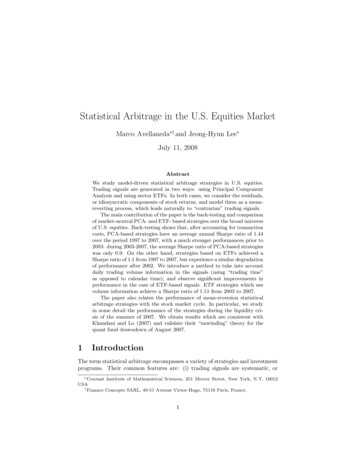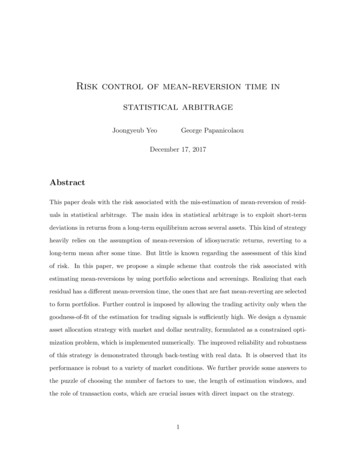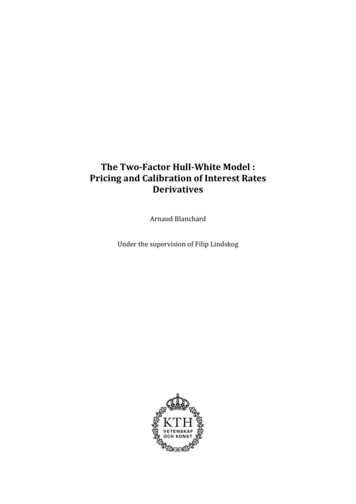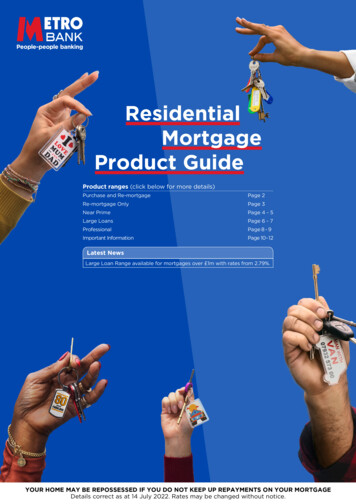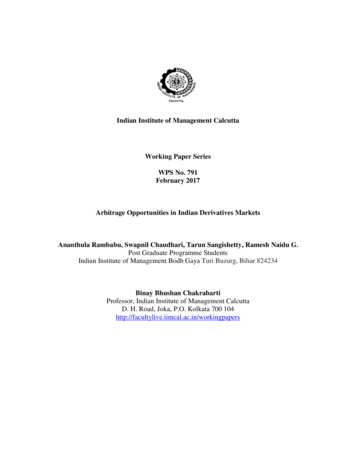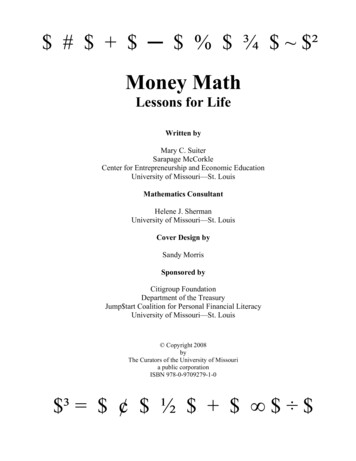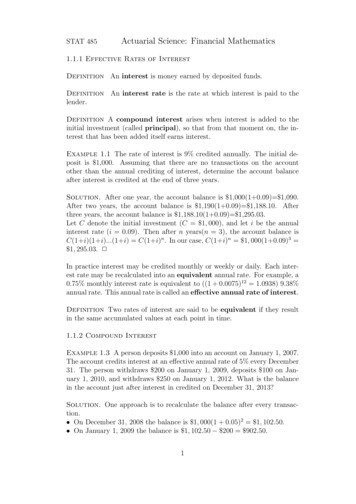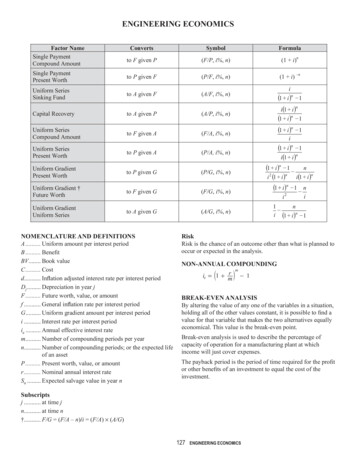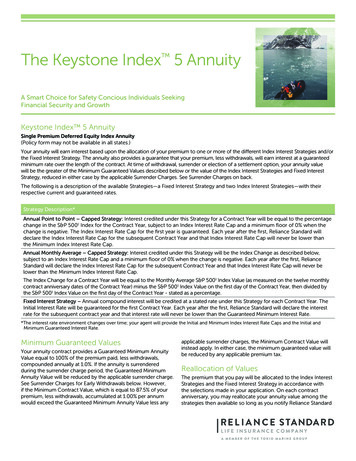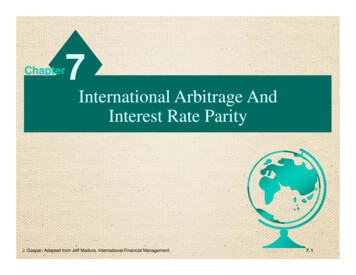
Transcription
Chapter7International Arbitrage AndInterest Rate ParityJ. Gaspar: Adapted from Jeff Madura, International Financial Management7. 1
Major International Finance TheoriesThe objective of International Finance theories is tounderstand how and why, in a system of freemarkets and flexible exchange rate, currencies striveto move toward equilibrium.These theories define the relationship betweenexchange rates (current spot, future spot, andforward), inflation, and nominal interest ratemovements.7. 2
Theory One: Interest Rate Parity (IRP)According to IRP, at equilibrium, the forward rate of aforeign currency will differ (in %) from the currentspot rate by an amount that will equal the interestrate differential (in%) between the home and foreigncountry.However, before one proceeds to discuss IRP, theconcept of currency arbitrage needs to be exploredfirst.7. 3
Chapter Objectives To explain the conditions that will result in variousforms of currency arbitrage, along with thecurrency realignments that will occur in response;and To explain the concept of interest rate parity, andhow it prevents foreign exchange arbitrageopportunities.7. 4
International Arbitrage Arbitrage can be defined as capitalizing on adiscrepancy in quoted prices to make a risk-freeprofit. The effect of arbitrage on demand and supply is tocause prices to realign, such that risk-free profit isno longer feasible. International Arbitragers play a critical role infacilitating exchange rate equilibrium. They try toearn a risk-free profit whenever there is exchangerate disequilibrium.7. 5
International Arbitrage As applied to foreign exchange and internationalmoney markets, international arbitrage (i.e., takingrisk-free positions by buying and selling currenciessimultaneously) takes three major forms: locational arbitrage triangular arbitrage covered interest arbitrage7. 6
Locational Arbitrage Locational arbitragers try to offset spot bid-askexchange rate disequilibrium Locational arbitrage is possible when a bank’s buyingprice (bid price) is higher than another bank’s sellingprice (ask price) for the same currency.ExampleBank CBidAskBank DBidAskNZ .635 .640NZ .645 .650Buy NZ from Bank C @ .640, and sell it to Bank D @ .645.Profit .005/NZ .7. 7
Triangular Arbitrage Triangular arbitragers try to offset cross-ratedisequilibrium Triangular arbitrage is possible when a crossexchange rate (exchange rate between two foreigncurrencies) quoted by a bank differs from the ratecalculated from dollar-based spot rate quotes.ExampleBidAskBank A: British pound ( ) 1.60 1.61Bank B: Malaysian ringgit (MYR) .200 .201Bank C: British pound ( )MYR8.10MYR8.20Calculated cross rate (A/B) MYR8.00MYR8.017. 8
Conducting Triangular Arbitrage Cross rates ( /MYR) are in disequilibrium andthere is room for risk-free profit if the Americanarbitrager had access to Challenges: US arbitragers do not (1) have , and(2) calculated cross rates are not quoted by banks Example: Let’s assume that the US arbitrager has 10,000 to invest in deal and let’s see how muchprofit could be made.7. 9
Profit from Triangular Arbitrage Sell 10,000 and buy from Bank A 10,000 1.61 6,211 Sell 6,211 to buy MYR at Bank C 6,211 x 8.10 MYR50,309 Sell MYR50,309 to buy at Bank B MYR50,309x 0.20 10,062 Triangular arbitrage profit 10,062 - 10,000 62 or ( 62/ 10,000)x100 0.62%7. 10
Triangular ArbitrageUS Value of in Value ofMYR in MYRValue of in MYR When the actual and calculated cross exchangerates differ, triangular arbitrage will force themback into equilibrium.7. 11
Covered Interest Arbitrage Covered interest arbitrage is the process ofcapitalizing on the interest rate differential (onassets of similar risk and maturity) between twocountries while covering for exchange rate risk. Covered interest arbitrage tends to force arelationship between forward rate premium ordiscount (difference between the forward and spotrate) and interest rate differentials.7. 12
Covered Interest ArbitrageExample spot rate 90-day forward rate 1.60U.S. 90-day interest rate 2%U.K. 90-day interest rate 4%Borrow at 3%, or use existing funds which areearning interest at 2%. Convert to at 1.60/ and engage in a 90-day forward contract to sell at 1.60/ . Lend at 4%.Note: Profits are not achieved instantaneously.7. 13
Comparing Arbitrage StrategiesLocational:ArbitrageCapitalizes on discrepancies inexchange rates across locations. / quoteby Bank X / quoteby Bank Y7. 14
Comparing Arbitrage StrategiesTriangular:ArbitrageCapitalizes on discrepancies incross exchange rates. / quoteby Bank A / quoteby Bank B / quoteby Bank C7. 15
Comparing Arbitrage StrategiesCoveredInterest :ArbitrageCapitalizes on discrepanciesbetween the forward rate and theinterest rate differential.Forward rateof quoted indollarsDifferentialbetween U.S.and Britishinterest rates7. 16
Comparing Arbitrage Strategies Any discrepancy will trigger arbitrage, which willthen eliminate the discrepancy, thus making theforeign exchange market more orderly.7. 17
Interest Rate Parity (IRP) As a result of market forces, the forward ratediffers from the spot rate by an amount thatsufficiently offsets the interest rate differentialbetween two currencies. Then, covered interest arbitrage is no longerfeasible, and the equilibrium state achieved isreferred to as interest rate parity (IRP).7. 18
Derivation of IRP When IRP exists, the rate of return achieved fromcovered interest arbitrage should equal the rate ofreturn available in the home country. End-value of a 1 investment in covered interestarbitrage (1/S) (1 iF) F (1/S) (1 iF) [S (1 p)] (1 iF) (1 p)where p is the forward premium.7. 19
Derivation of IRP End-value of a 1 investment in the home country 1 iH Equating the two and rearranging terms:(1 iF) (1 p) 1 iHp (1 iH)(1 iF)–1i.e.forwardpremium (1 home interest rate)(1 foreign interest rate)–17. 20
Determining the Forward PremiumExample Suppose 6-month ipeso 6%, i 5%. From the U.S. investor’s perspective,forward premium (1.05/1.06) – 1 - .0094 If spot rate, S .10/peso, then6-month forward rate S (1 p) .10 (1.0094) .09906/peso7. 21
Determining the Forward Premium The IRP relationship can be rewritten as follows:F–SS S(1 p) – SS p (1 iH)(1 iF)–1 (iH–iF)(1 iF) The approximated form, p iH – iF, provides areasonable estimate when the interest ratedifferential is small.7. 22
Graphic Analysis of Interest Rate ParityInterest Rate Differential (%)home interest rate – foreign interest rate42ForwardDiscount ofFC (%)-3YIRP lineZB1-1X3 ForwardPremium ofFC(%)-2AW-47. 23
Graphic Analysis of Interest Rate ParityInterest Rate Differential (%)home interest rate – foreign interest rate4Zone of potentialcovered interestIRP linearbitrage by2foreign investorsForwardDiscount ofFC (%)-3-113 ForwardPremium ofFC (%)-2-4Zone of potentialcovered interestarbitrage bylocal investors7. 24
Test for the Existence of IRP To test whether IRP exists, collect actual interestrate differentials (assets of similar risk andmaturity) and forward premiums/discounts forvarious currencies, and plot them on a graph. IRP holds when covered interest arbitrage is notpossible or worthwhile.7. 25
Interpretation of IRP When IRP exists, it does not mean that both localand foreign investors will earn the same returns. What it means is that investors cannot usecovered interest arbitrage to achieve higherreturns than those achievable in their respectivehome countries.7. 26
Does IRP Hold?Forward RatePremiums andInterest RateDifferentials forSeven Currencies7. 27
Does IRP Hold? Various empirical studies indicate that IRPgenerally holds. While there are deviations from IRP, they are oftennot large enough to make covered interestarbitrage worthwhile. This is due to the characteristics of foreigninvestments, such as transaction costs, politicalrisk, and differential tax laws.7. 28
Considerations When AssessingIRPTransaction CostsiH – iFZone of potentialcovered interestarbitrage byforeign investorsZone wherecovered interestarbitrage is notfeasible due totransaction costsIRP linepZone ofpotentialcoveredinterestarbitrageby localinvestors7. 29
Considerations When AssessingIRPPolitical Risk A crisis in a country could cause its government torestrict capital outflow and impose exchange controls(exchange of the local currency for reserve currencies). Investors may also perceive a higher default risk onforeign investments.Differential Tax Laws If tax laws vary, after-tax returns should be consideredinstead of before-tax returns.7. 30
Changes in Forward Premiums
Covered Interest Arbitrage Example spot rate 90-day forward rate 1.60 U.S. 90-day interest rate 2% U.K. 90-day interest rate 4% Borrow at 3%, or use existing funds which are earning interest at 2%. Convert to at 1.60/ and engage in a 90-day forward contract to sell at 1.60/ . Lend at 4%.
